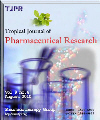
|
Tropical Journal of Pharmaceutical Research
Pharmacotherapy Group, Faculty of Pharmacy, University of Benin, Benin City, Nigeria
ISSN: 1596-5996
EISSN: 1596-5996
Vol. 9, No. 3, 2010, pp. 283-291
|
 Bioline Code: pr10035
Bioline Code: pr10035
Full paper language: English
Document type: Research Article
Document available free of charge
|
|
|
Tropical Journal of Pharmaceutical Research, Vol. 9, No. 3, 2010, pp. 283-291
| en |
Formulation of Sustained-release diltiazem matrix tablets using hydrophilic gum blends
Moin, Afrasim & Shivakumar, H.G.
Abstract
Purpose: To develop sustained release matrix tablets of diltiazem hydrochloride (DTZ) using karaya gum (K) alone or in combination with locust bean gum (LB) and hydroxypropyl methylcellulose (H).
Methods: Matrix tablets of DTZ were prepared at different ratios of drug:gum (1:1, 1:2, and 1:4) and of the gum blends (K, K/LB, K/H and K/LB/H) by direct compression. The matrix tablets were evaluated for hardness, friability, in vitro release and drug content. The formulations were also characterised by scanning electron microscopy (SEM), Fourier transform infra-red spectroscopy (FTIR) and differential scanning calorimetry (DSC). A commercial diltiazem hydrochloride product Dilzem SR, was used as a reference for comparison.
Results: Tablets with only K or K/H had the highest mean dissolution time (MDT), the least dissolution efficiency (DE, 12 %), and released drug by swelling, diffusion and erosion mechanisms. Karaya gum or combinations with locust bean gum sufficiently controlled drug release, while combinations of KH and KLBH exhibited high and low drug release efficiency, respectively. SEM images of the tablets before and after dissolution showed morphological changes on the tablet surface while FTIR and DSC studies indicate that there was no chemical interaction between the drug and the polymers. Three of the formulations compared well with the reference (p < 0.05) in terms of release characteristics.
Conclusion: The results of the study demonstrate that karaya gum alone or in suitable combination with locust bean gum and hydroxypropyl methylcellulose is suitable for formulating sustained-release matrix tablets of diltiazem.
Keywords
Karaya gum, Locust bean gum, Diltiazem hydrochloride, Sustained release, Hydroxypropyl methylcellulose
|
| |
© Copyright 2010 Tropical Journal of Pharmaceutical Research.
Alternative site location: http://www.tjpr.org
|
|
